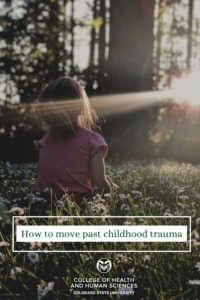When you reflect on your early years, what are some memories that come to mind? For some, this question may elicit feelings of warmth, security, and nostalgia. Perhaps you’re envisioning your caretakers smiling or cheering for you, playing outside with your siblings or friends, or cozying up with your family for dinners, movie nights, or other adventures. These memories may be accompanied by echoes of laughter, singing, or music.
However, some readers may view this rose-colored description skeptically, with only a portion of the discussed elements matching their experience, and others may find this portrayal completely unrealistic. There are many people with childhoods that are filled with darker memories, and in some cases, these memories outnumber the positive, happy ones. Despite the widely held misconception that children can outgrow distressing memories and experiences on their own, the pain of childhood trauma can linger for decades.
What is childhood trauma?
Ultimately, traumatic experiences incite strong emotions and physical reactions that persist long after the event. When thinking of trauma, most people imagine pivotal, life-changing events, such as car accidents and severe natural disasters. These are experiences that can separate an individual’s life into “before” and “after.” While these events are undoubtedly harmful to developing children, it is also important to understand how these traumatic experiences differ from complex trauma.
What is complex trauma?
Sometimes, young people are repeatedly exposed to traumatic events, and this is defined as complex trauma. Individuals experiencing complex trauma are often unable to imagine their lives without the trauma. These experiences can involve physical, sexual, or psychological abuse, neglect, community violence, parental substance abuse or conflict, and other adverse experiences (Wu, 2019). Often, survivors find it difficult to distinctively pinpoint, recall, and describe these experiences. For some, memories appear as general feelings of detachment. For others, these experiences appear as snapshots from childhood, like eating meals alone at the kitchen table and waiting for an absentee parent to return home. Altogether, the cumulative effects of these experiences have been shown to profoundly impact individuals’ long-term psychological, emotional, and physical health and well-being.
How can traumatic childhoods and uncertain futures?
The knowledge of these effects may feel overwhelming and disheartening. You may be wondering what can be done to reverse these effects. Research indicates that trauma becomes embedded in the mind and body when the emotions generated during the traumatic experience are left unprocessed. Until these emotions are addressed, they continue affecting the lives of individuals. Because children are unable to differentiate their feelings from their identities, undesirable feelings may leave many children feeling unaccepted. To effectively heal from childhood trauma, the individual must learn to recognize and process their emotions (Brandt, 2017). Complete the following exercise with small traumas and begin moving towards larger traumas once comfortable with this technique.
- Grounding: Find a relaxing, safe place, sit comfortably, and take several deep breaths. Bring your attention to your body, tense and release your muscles, allow yourself to feel connected to the ground beneath you. Imagine energy flowing from your tailbone to the center of the earth.
- Recalling: Think of a situation that has upset you recently. Revisit the sequence of events in detail and envision yourself back in this time and place. Imagine this experience with your senses.
- Sensing: Scan your body for sensations, and curiously observe each of these physical reactions. Silently describe them to yourself.
- Naming: Connect your sensations to emotions. It may be helpful to view a list of emotions before this step.
- Loving: Accept your feelings. Repeat, “I love myself for feeling _____.”
- Feeling: Allow your feelings to come and go. Observe and acknowledge them and express your emotions constructively.
- Receiving wisdom: Connect your current emotions with past experiences. Do they provide insight. Ask yourself, “What is this sensation or emotion saying to me?”
- Sharing: Discuss or write about your experiences and emotions.
- Letting go: Visualize the energy of your trauma as leaving your body.
Although this process may feel uncomfortable, this exercise can lead to a sense of empowerment.
If this exercise seems overwhelming, trauma-informed therapy is always an option. In this setting, you can learn to safely hold your emotions until you are ready to begin processing them. This treatment also allows you to rewrite your story and reclaim control over your life. As cliché as this sounds, your story belongs to you, and you have the power to rewrite its ending.
If you would like additional support navigating the realities of this time, the CSU Center for Family and Couple Therapy has registered counselors available to meet with you now. The CFCT is currently providing all Colorado residents low-cost individual, couple, and family online video sessions during daytime and evening hours to fit your schedule. To schedule an appointment, please call (970) 491-5991 or email cfct@colostate.edu.
References
Brandt, A. (2017). Mindful aging: Embracing your life after 50 to find fulfillment, purpose, and joy. Eau Claire, WI: PESI Publishing & Media location.
Morin, A. (2020). Treating the effects of childhood trauma. Retrieved from https://www.verywellmind.com/what-are-the-effects-of-childhood-trauma-4147640
Wu, J. (2019). Three ways childhood trauma affects adulthood. Retrieved from https://www.psychologytoday.com/us/blog/the-savvy-psychologist/201910/three-ways-childhood-trauma-affects-adulthood